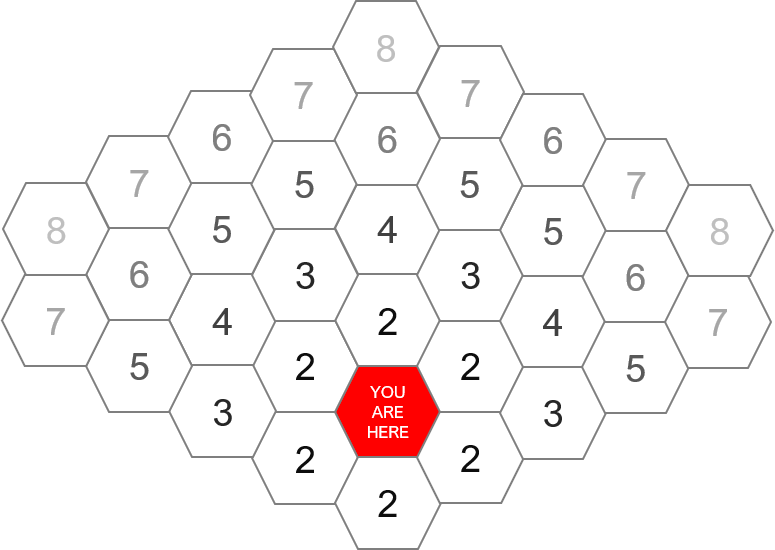

This page covers the basics of movement. There are many ways for creatures to move from one location to another. The method, and the level of detail given by the GM, depends on the circumstances and the current mode of gameplay.
During the Adventure mode, the player characters' speed is not taken into consideration. As characters walk between rooms and areas, they may passively notice things about their environment using their passive perception.
Walking on stable terrain does not require any skill checks, however, characters may need to make one of many types of special movement skill checks (usually Athletics) when facing more difficult terrain:
Main Page: Travel
During Adventuring, it may sometimes be necessary for the party to travel great distances to reach their next objective. The methods of long-distance travel available will depend on the setting of your specific module and the party's resources.
In long-distance travel, the GM may summarize the trip without detailing every moment of it or calculating the exact distance and time, only stopping if the party runs into a problem along the way.
While in combat, you may use any number of action frames to move. Your speed is the maximum distance in feet you can move in one frame. On hazardous terrain, you move at half your speed, rounded down. Movement is not subject to the Spam Tax.
Action frames are indivisible. This means you must always round up when determining the number of frames needed to move a given distance. For example, in order for a creature with a speed of 6 feet to move 7 feet, they must use two frames to move.
Movement and positioning in combat can be represented using a combat board. mRPG supports the use of either square or hexagonal boards.


On a square-based board, each square is 2 by 2 feet. Movement in any of the cardinal directions equals 2 feet per square, while diagonal movement equals 3 feet per square.
On a hexagonal board, movement to any adjacent space equals 2 feet, while movement "down the line" between parallel spaces equals 3 feet.


You keep your balance while moving across a narrow, unstable, or slippery surface. Make a Balance (Agility) skill check, the difficulty of which depends on the surface itself.
| Success: | You move across the surface at half your speed until you next stop moving or you leave the dangerous area. |
| Critical Success: | You move across the surface at full speed. |
| Failure: | You must remain still to keep your balance (you waste the action frame.) |
| Critical Failure: | You slip and fall prone. |

You hide in plain sight, moving through an unfamiliar area with unfamiliar people while acting like you belong. This can be done with or without a disguise. As long as you don't do anything overtly suspicious, no one will be any the wiser.
Make a single Blend In (Performance) skill check. Each other creature contests this with a Suspicion (Insight) check. If you are in a large crowd, those creatures may have disadvantage, and some creatures may not pay you enough mind to warrant a check, at the GM's discretion. Although you are not attempting to imitate a specific person, a generic disguise may grant a circumstance bonus, at the GM's discretion.
| Success: | Each creature you succeed against isn't suspicious of you and goes about their business normally. |
| Failure: | Each creature you fail against thinks there's something fishy about you and may confront you to find out more. The player or GM determines their response. |
| Critical Failure: | A creature you critically fail against knows immediately that you aren't supposed to be there, and knows what are actually up to. |


Main Page: Climbing
You move up, down, or across ropes, a steep incline, a vertical surface with handholds, or even a ceiling. The difficulty is set by the GM based on the type of terrain and direction of movement.
| Success: | You climb at half your speed. |
| Critical Success: | You climb at your normal speed. |
| Failure: | You slip downwards by 1 foot and must remain still to avoid falling. Depending on the type of surface the GM may call for an Endurance save to avoid falling. |
| Critical Failure: | You fall. |


You crawl along the ground at half your speed, allowing you to squeeze into smaller spaces. You must be prone in order to crawl.


You move quietly through an area so as not to be noticed.
You may start sneaking whenever the creature(s) you're attempting to hide from can't see or hear you. Make a Stealth check and note the result - this becomes your perception difficultyuntil you stop sneaking or attempt another action. Remember that your character doesn't know their perception DC.
While sneaking, you move at half speed. You can stop sneaking at any time.
Creatures that are not actively searching for you contest your check with their passive perception. Those that are searching for you must beat your perception difficultywith a Search (Perception) check of their own. If a creature passively hears you, they may begin searching for you, but you remain hidden unless they find you.

You run as fast as you can. You Sprint at double your usual speed, or normal speed across hazardous terrain.
Make a Sprint (Athletics) check. The typical difficutly is 15, but the GM may adjust this depending on the terrain.
| Success: | Your Speed is doubled until the end of the current turn. You can use any number of additional movement actions to move at sprint speed this turn, but each frame after the first causes you to become Winded 1. |
| Critical Success: | Your Speed is doubled until the end of the current turn, and you can use any number of actions to move at sprint speed without becoming winded. |
| Failure: | You move at your normal speed. |
| Critical Failure: | You might stumble and fall prone or injure yourself. |



Main Page: Swimming
You swim through water. To swim on the surface of calm water, no skill check is needed. To swim underwater or through current, make an Athletics check.
Assistance: Helpers make a Swimming (Athletics) check.
| Success: | You swim at half your Speed in any direction. |
| Failure: | You are pushed by the current if there is one, or you sink if the current is pulling you down. |

You wade through a body of water up to 4 feet deep. You move at half speed, but you can perform most actions normally.

You walk or run up to your Speed for each frame of movement.